What is a REST API?
Summary
TLDRIn this educational video, Nathan Heckman from IBM Cloud explains the concept of REST APIs using an ice cream shop analogy. He clarifies that REST stands for Representational State Transfer, a standardized software architecture style for APIs. The benefits highlighted include simplicity, scalability, statelessness, and high performance due to caching. Heckman illustrates REST API components like endpoints, HTTP methods corresponding to CRUD operations, and the request-response structure. The example demonstrates how REST APIs can be used to manage and update ice cream flavors in a web application, emphasizing their fundamental role in cloud application development.
Takeaways
- 📚 **REST API Definition**: REST stands for Representational State Transfer, which is a standardized software architecture style for APIs.
- 🌐 **Communication Focus**: REST APIs are all about communication between a client and a server, facilitating interactions in a standardized way.
- 🔑 **Stateless Nature**: REST APIs are stateless, meaning they do not store client state, which simplifies scalability and reduces complexity.
- 🔄 **Scalability**: They are designed to be scalable, allowing for easy modifications as services grow in complexity.
- ⚡ **High Performance**: REST APIs support caching, which contributes to their high performance even as services scale.
- 🍦 **Real-world Application**: The script uses an ice cream shop's web application as an example to illustrate how REST APIs can be used in practice.
- 📝 **CRUD Operations**: REST APIs use HTTP methods like GET, POST, PUT, and DELETE to perform CRUD operations on resources.
- 📊 **Endpoints and Resources**: An endpoint like '/api/flavors' in the example represents a resource, which is the subject of the API's operations.
- 🔗 **Request Components**: A REST API request includes an HTTP method, endpoint, parameters or body, and headers, which may contain authentication data.
- 📡 **Response Format**: The server's response to a REST API request is typically in JSON format, providing structured data to the client.
- 🛠️ **Development Fundamentals**: REST APIs are fundamental to cloud application development due to their standardized approach, scalability, and performance benefits.
Q & A
What does 'REST' stand for in the context of APIs?
-REST stands for Representational State Transfer, which is a standardized software architecture style for APIs that is widely recognized and used in the industry.
What is the significance of a REST API in cloud application development?
-REST APIs are fundamental to cloud application development because they provide a simple, standardized approach to communication between the client and server, ensuring scalability, statelessness, and high performance.
How does a REST API facilitate communication in a web application?
-A REST API allows a web application to communicate with a cloud-based server by sending requests and receiving responses, enabling the application to perform actions such as retrieving data or updating information.
What is the meaning of 'stateless' in the context of REST APIs?
-In the context of REST APIs, 'stateless' means that the server does not store any session data or information about the client between requests, simplifying the architecture and making it easier to scale.
Why are REST APIs considered scalable?
-REST APIs are considered scalable because they can handle an increasing amount of requests as the service grows in complexity without a significant drop in performance, thanks to their stateless nature and support for caching.
What is an endpoint in a REST API?
-An endpoint in a REST API is a specific URL that represents a resource and defines the location where a client can send requests to interact with that resource.
What does the acronym 'CRUD' stand for in the context of REST APIs?
-CRUD stands for Create, Read, Update, and Delete, which are the main actions that can be performed with a REST API to interact with resources.
How do HTTP methods correspond to CRUD operations in a REST API?
-In a REST API, the HTTP methods correspond to CRUD operations as follows: POST for 'Create', GET for 'Read', PUT for 'Update', and DELETE for 'Delete'.
What is a 'resource' in the context of a REST API?
-In the context of a REST API, a 'resource' is a data object or collection of data that can be accessed and manipulated through the API, such as 'flavors' in the ice cream shop example.
Can you provide an example of how a REST API request might look for retrieving data?
-An example of a REST API request for retrieving data would be a GET request to an endpoint like '/api/flavors', which would return a list of available ice cream flavors in stock.
How does a REST API support caching and why is this beneficial?
-REST APIs support caching by using HTTP headers to indicate that responses can be stored and reused for subsequent requests without the need to refetch the data from the server, which improves performance and reduces load on the server.
Outlines

This section is available to paid users only. Please upgrade to access this part.
Upgrade NowMindmap

This section is available to paid users only. Please upgrade to access this part.
Upgrade NowKeywords

This section is available to paid users only. Please upgrade to access this part.
Upgrade NowHighlights

This section is available to paid users only. Please upgrade to access this part.
Upgrade NowTranscripts

This section is available to paid users only. Please upgrade to access this part.
Upgrade Now5.0 / 5 (0 votes)





